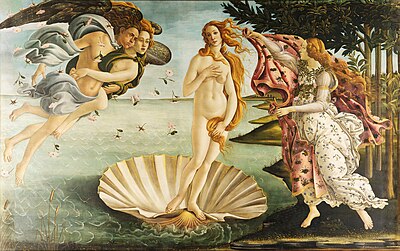Sandro Botticelli
Alessandro di Mariano di Vanni Filipepi (c. 1445[1] – May 17, 1510), known as Sandro Botticelli (/ˌboʊtiˈtʃɛli/, Italian: [ˈsandro bottiˈtʃɛlli]), was one of the greatest painters of the Florentine Renaissance. His The Birth of Venus and Primavera are often said to epitomize for modern viewers the spirit of the Renaissance. His most famous painting is Birth of Venus, however he does have a lot of famous artworks: Fortitude, Madonna and Child, Adoration of the kings and many more. His auction record tops 10 million. Sandro Botticelli was unique; he was influenced by the revival of Greek and roman ideas in Florence at the time, Botticelli was one of the first western artists since classical times to depict non religious subject matter
Young Botticelli[change | change source]

Botticelli was born in Florence in the working-class rione of Ognissanti. At first he did an apprenticeship to become a goldsmith. Following the boy's wishes, his doting father sent him to Fra Filippo Lippi. Lippi was working on frescoing the Convent of the Carmine. Lippi's synthesis of the new control of three-dimensional forms, tender expressiveness in face and gesture, and decorative details inherited from the late Gothic style were the strongest influences on Botticelli. Another influence were the Pollaiuolo brothers.They were doing a series of Virtues for the Tribunale or meeting hall of the Mercanzia. This hall was a cloth-merchants' confraternity.Botticelli contributed to this the Fortitude, dated 1470 in the Uffizi Gallery.
He was an apprentice too of Andrea del Verrocchio, where Leonardo da Vinci worked beside him, but he made his name in his local Church of Ognissanti, with a St. Augustine that successfully competed as a pendant with Domenico Ghirlandaio's Jerome on the other side "the head of the saint being expressive of profound thought and quick subtlety" (Vasari). In 1470 he opened his own independent studio.
Being discovered by the Medici[change | change source]
Lorenzo de' Medici was quick to employ his talent. Botticelli made consistent use of the circular tondo form and did many beautiful female nudes, according to Vasari. The Birth of Venus was at the Medici villa of Castello.
Influences of religion on Botticelli[change | change source]
Sandro was intensely religious. In later life, he was one of Savonarola's followers. Botticelli burned his own paintings on pagan themes in the notorious "Bonfire of the Vanities". Earlier, Botticelli had painted an Assumption of the Virgin for Matteo Palmieri in a chapel at San Pietro Maggiore. In this painting, it was rumored, both the patron who dictated the iconic scheme and the painter who painted it, were guilty of heresy. People did not say what kind of heresy it was. The ideas that could be seen as heresy seem to be gnostic in character:
- "By the side door of San Piero Maggiore he did a panel for Matteo Palmieri. In it, a large number of figures represent the Assumption of Our Lady with zones of patriarchs, prophets, apostles, evangelists, martyrs, confessors, doctors, virgins, and the orders of angels, the whole from a design he received from Matteo. Matteo was a worthy and learned man. Botticelli executed this work with the greatest mastery and diligence. He introducing the portraits of Matteo and his wife on their knees. But although the great beauty of this work could find no other fault with it, people said that Matteo and Sandro were guilty of grave heresy. If this is true or not, I cannot say." (Vasari, about Botticelli)
This is a common misunderstanding. It is based on a mistake by Vasari. The painting referred to here, now in the National Gallery in London, is by the artist Botticini. Vasari confused their similar sounding names.
Other influences[change | change source]

The Adoration of the Magi for Santa Maria Novella, ca1476, contains portraits of Cosimo de' Medici ("the finest of all that are now extant for its life and vigour"), his grandson Giuliano de' Medici, and Cosimo's son Giovanni, were effusively described by Vasari:
- "The beauty of the heads in this scene is indescribable, their attitudes all different, some full-face, some in profile, some three-quarters, some bent down, and in various other ways, while the expressions of the attendants, both young and old, are greatly varied, displaying the artist's perfect mastery of his profession. Sandro further clearly shows the distinction between the suites of each of the kings. It is a marvellous work in colour, design and composition."
In 1481, Pope Sixtus IV summoned him and prominent Florentine and Umbrian artists who had been summoned to fresco the walls of the Sistine Chapel. The iconological program was the supremacy of the Papacy. Sandro's contribution was moderately successful. He returned to Florence, and "being of a sophistical turn of mind, he there wrote a commentary on a portion of Dante and illustrated the Inferno which he printed, spending much time over it, and this abstension from work led to serious disorders in his living." Thus Vasari characterized the first printed Dante (1481) with Botticelli's decorations; he could not imagine that the new art of printing might occupy an artist. As for the subject, when Fra Girolamo Savonarola began to preach hellfire and damnation, the susceptible Sandro Botticelli became one of his adherents, a piagnone left painting as a worldly vanity, burned much of his own early work, fell into poverty as a result, and would have starved but for the tender support of his former patrons.
Related pages[change | change source]
References[change | change source]
- ↑ Ettlingers, 7. Other sources give 1446, 1447 or 1444–45.
